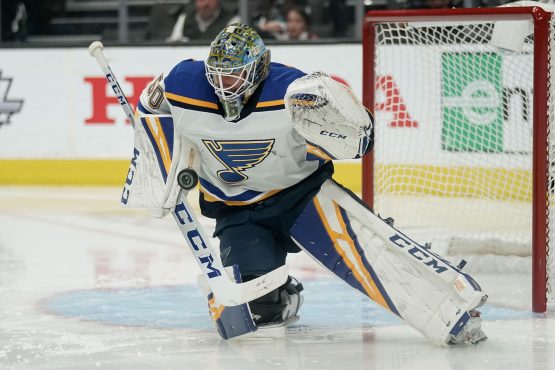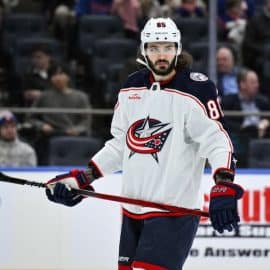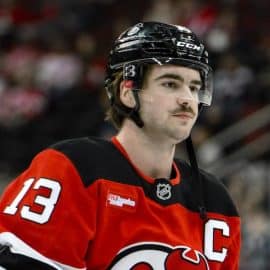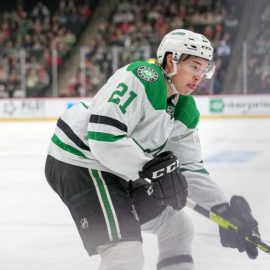Pierre Dorion does love him some goalies.
Since taking over the general manager duties in 2016, the Senators’ exec has dealt for Mike Condon, Anders Nilsson and prospect Filip Gustavsson to help buoy the Senators’ depth at the position while trading draft picks to move up at the 2019 NHL Draft to select Mads Sogaard in the second-round last year.
When it comes to adding goaltenders, it would be hard to believe that anyone has been more active than Dorion, but according to a recent report by TSN’s Frank Seravalli, the Senators are interested in the Pittsburgh Penguins’ Matt Murray – who TSN lists as the number one trade target on their trade bait board.
Frank Seravalli: “The Pittsburgh Penguins are believed to have one standing offer on the table for Matt Murray. The Maple Leafs, Oilers, Flames, Senators, Sabres and Avalanche are among the potential suitors for Murray’s services – a list that may soon grow.” #LetsGoPens
— NHL News (@PuckReportNHL) September 3, 2020
The justification for seeing Murray’s name circulate in trade rumours is easy to understand. With an aging core and a diminishing Cup window centred around winning while Evgeni Malkin and Sidney Crosby can still help carry the Penguins, Jim Rutherford can shed Murray to recoup some assets and reallocate money to address other weaknesses on the Penguins’ roster.
Thanks to the emergence of Tristan Jarry as a viable alternative and the fact that it just isn’t that difficult to find average NHL goaltending on the cheap, moving Murray makes sense for the organization.
The question is, does it make sense for the Ottawa Senators?
For a 26-year old goaltender who already has his name on two Stanley Cups, proponents of acquiring Murray will allude to his age and winning pedigree to assert that he would be a nice fit in the sense that when the Senators are poised to be competitive again, Murray could still be on the right side of 30 years of age.
You know who else won two Stanley Cups before his 26th birthday playing for a perennial contender though?
Chris Osgood.
Like Osgood, there’s no denying that Murray has proven himself at times to be a successful goalie on a good team, but you can’t help but have some serious reservations about going all-in on such a risky player.
In any transaction however, what ultimately matters for the Senators is the opportunity cost it will take to acquire him.
For the same reasons that people will like Murray as an acquisition, his age and championship resume creates the risk that the Senators would overpay in assets to acquire a goaltender based solely on his past accomplishments.
The greatest concern with Murray lies in the fact that after winning the Stanley Cup in 2016 and posting an excellent statistical line during the 2016-17 season, he has been wildly inconsistent over the past three seasons according to his goals saved above average (GSAA) and goals saved above expected (GSAx).
The following stats are from Evolving-Hockey.com’s dataset:
| Season | GSAA | Rk | GSAx | Rk |
| 2016-17 | 13.04 | 8th | 16.99 | 6th |
| 2017-18 | -6.97 | 74th | -7.60 | 72nd |
| 2018-19 | 10.17 | 14th | -0.08 | 30th |
| 2019-20 | -10.59 | 78th | -13.49 | 78th |
Murray’s career has gone through some volatile swings, but to put into perspective just how bad his performance was this past season, you just need to understand that his GSAA and GSAx both ranked in the bottom 10 amongst qualified goaltenders.
Based on his 2019-20 season alone that saw Tristan Jarry pass him on the depth chart, Murray he has to be viewed as a reclamation project, so the cost to acquire him should reflect that.
If the league interest in Murray is as serious and widespread as Seravalli is leading people to believe, buying low on Murray simply may not be an option.
Keep in mind that any trade scenario involving Murray is not akin to me suggesting earlier this year that the Senators should look at bringing Robin Lehner back via free agency.
Rather than simply costing the Senators money, trading for Murray means that some combination of NHL-ready assets, prospects and draft picks will be moved to the Penguins. And for what it’s worth, Murray’s qualifying offer as a restricted free agent will have to match the $3.75 million that he earned in 2019-20.
For the rebuilding Senators, there is simply no pressure to win or be more competitive right away. They already have Anders Nilsson and Marcus Hogberg who played in a combined 54 NHL games for the Senators last season.
With prospects like Joey Daccord, Filip Gustavsson, Mads Sogaard and Kevin Mandolese in the system, there is also a pipeline of goaltending depth there that at the very least should be able to play in NHL games at some point in the near future.
Whether any of these prospects profile as a number one right now or will reach that level in the future remains to be seen, but this depth and lowly expectations placed upon this organization should afford the front office time and patience to see what they have before looking to move significant assets for a goaltender who carries this much risk.
The timing does not make sense and from an asset management perspective, the Senators would be better served continuing to stockpile these young assets in hopes that they either develop well for this organization or allow the team to go out and acquire a higher caliber alternative who carries significantly less risk. In being patient, the Senators can simply continue to build their depth and afford management a better opportunity to land a better talent at a more critical juncture when the team is actually good. And at the very least, this added time allows the front office to have a better gauge on what kind of upside their young goaltending prospects have.
Too often in this organization’s recent history, they have expended countless valuable young players and draft picks to acquire good but not great players. Not only have these players failed to move the needle much, but the opportunity cost involved has often robbed the Senators of the depth they need to support these players properly.
Add The Sports Daily to your Google News Feed!





